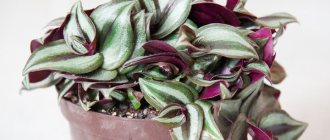Date of publication: April 02, 2020. Category: Garden and vegetable garden.
Rating 5.00 [4 vote(s)]
You don’t have to go to the store to buy delicious ripe fruits; you can grow them on the windowsill of your apartment. Lemons, oranges, tangerines grow well in our homes and produce a good harvest.
If you have no experience growing fruits at home, it is better to start with citrus fruits. They are very beautiful and it is much easier to get fruit from them than from pineapple or figs. In just a couple of years you will be drinking tea with lemon, the fruits of which you grew yourself, or treating friends with your own tangerines. In addition, indoor fruits taste better than ground and overseas ones, they have few seeds and the peel is not as thick as store-bought citrus fruits.
How to grow lemon
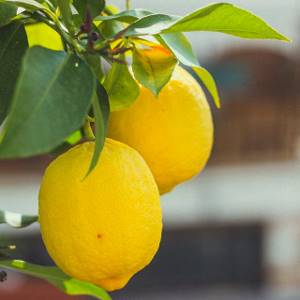
Do not throw away the seeds of an orange or lemon bought in a store, but plant it in a pot. You will get a viable plant, but you will have to wait eight to ten years for a harvest from them. If you don't want to wait that long, buy cuttings at the store. Consult with the seller to choose for you the variety of citrus plant that would grow without problems in the unusual conditions for a plant in a city apartment, where there is dry air and a lack of light. You can contact citrus growers via the Internet and purchase cuttings from them.
First, place the cutting in a small container and cover it with clean, damp river sand. After just a couple of months, you will notice that the cuttings have completely taken root and adapted to home conditions. Now you can transplant the plant, which has already produced leaves and lateral buds, into good soil.
When growing lemon in an apartment, you should remember that in our apartments the humidity is only 20-25% due to heated central heating radiators, and the plants come from the subtropics, where humidity is always high. Therefore, the leaves of the plant evaporate so much water that the root system begins to malfunction and leaves begin to fall out. For the winter, you can try covering the trees with a plastic bag, this will increase the humidity. And you need to spray the plant with warm water at least once a week. And when the tree grows, do this even more often. Such an artificial increase in humidity is simply necessary for citrus fruit.
If the weather is not frosty, try to open the window more often so that humid air from the street enters the apartment. The soil in the pot should always be moist, but at the same time, excessive watering is also extremely harmful to the plant. If the lump of earth does dry out, put the pot with your lemon or tangerine in water and let it drink plenty of moisture, otherwise it will be difficult to wet the dry lump of earth later. For irrigation, it is advisable to use rainwater or melted snow.
In winter, the soil in the pot may freeze on the windowsill, followed by the plant itself. Watch this carefully and do not let your tree die. By the way, a small pot will do for citrus fruit; in a large pot the soil may become acidified.
Lemon loves sunlight very much, so place the pot with the tree on the sunny side of the apartment. The plant needs at least 12 hours of sunlight a day. But in winter there is little sun, so artificial lighting is required. In addition, it is required that the lighting be uniform. Therefore, in the summer, for example, plant a plant in the northwestern part of the apartment, and in the winter place it on the southeastern side.
In apartment conditions, lemon varieties such as Mir and Pavlovsky are usually grown. The world loves light very much and will shed its leaves when there is a lack of light. But the plant is resilient and many citrus growers get 10-12 lemons per bush. Pavlovsky has larger fruits and is perfect for growing on a windowsill.
Exotic plants on an indoor windowsill (photo)
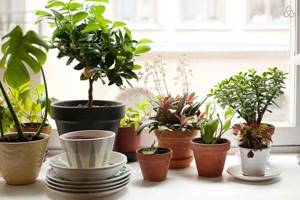
Exotic plants in apartments and houses have long ceased to be a rarity in all regions of our country. There are quite a lot of them. There will be some subtleties in care, but growing exotics will not be difficult.
Conventionally, such plants can be divided into several groups:
– blooming
– fruit (citrus and oriental)
– exotics
- spices
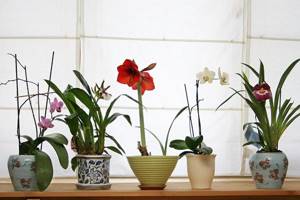
Of the flowering ones, the most popular are orchids . The diversity of these flora representatives is very great. As representatives of eternal summer, they need an abundance of sunlight, warmth and humid air all year round. Feels great on southern window sills without requiring shading.
To avoid stagnation of moisture in the soil, you will need special pots with a sufficient number of holes. For these purposes, it is good to choose a plastic flowerpot, ceramics or hanging basket.
Watering is required when the soil is almost completely dry. Water with soft, warm, settled water. Provide orchids with high humidity. They need him. For these purposes, it is a good idea to purchase an indoor fountain or humidifier.
Protect this gentle creature from drafts. In the cold season, some varieties require mandatory rest, and therefore exist comfortably at an air temperature of 15 degrees. The temperature at the time of flowering should be increased to 22 degrees or more.
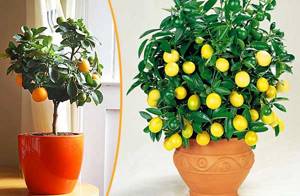
The most common citrus fruits planted on the windowsill in an apartment are lemons, tangerines, oranges and limes . Bergamot is also in demand among gardeners. The latter is less whimsical than other representatives of citrus fruits.
It is easy to grow such plants from fruit seeds purchased in the store. True, most likely there will be no fruit on such trees. To do this, citrus fruits need to be grafted or propagated by vegetation.
Light and warmth are important conditions for good growth. As well as timely watering. The water should be soft. Leave for at least a day. The chlorine contained in the water will destroy these plants. Watering should be plentiful. The soil should not be allowed to dry out. A shower will bring great joy to citrus trees.
Lighter soil is selected for young seedlings, and heavier soil for adult plants.
In February, citrus fruits begin to emerge from the dormant phase and confidently begin to grow. At this time, it is necessary to provide them with additional feeding. Pinching the top shoots will help to form a beautiful bush that will delight you with an abundance of greenery, flowers and fruiting.
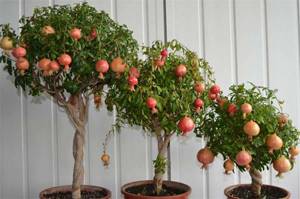
The dwarf pomegranate feels good on the windowsill . Like citrus fruits, it can be grown from fruit seeds purchased in the store. Unlike lemons and oranges, it can bear fruit. The top of the crown needs to be trimmed annually.
Watering is moderate, with warm and settled water. Easily tolerates some drying out of the soil, dry air and low temperatures. During flowering and fruiting, watering is increased. Like everything else, you need a lot of light at any time of the year. The tree grows up to 1 meter in height. Therefore, it is important to select a suitable container with well-drained soil and a place in the room. After 8-9 months, with proper care, the pomegranate begins to bloom. Good feeding and fertilizers at this time will help the tree gain strength and ensure abundant fruiting.
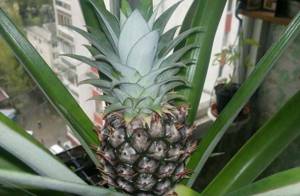
A pineapple on the windowsill will bring great joy Growing this exotic plant will not cause many difficulties.
Planting is best done in late spring. To do this, the top of the purchased pineapple is cut off and cleared of pulp and lower leaves. Then it is placed in a container with water until roots appear. After this, the plant is planted in a wide pot with the prepared mixture. Otherwise, any soil will do.
Watering is moderate. But the sun is in large quantities. Air temperature 22-25 degrees.
Pineapple bears fruit only once during its life. It begins to bear fruit at 3-4 years of age. Ripens six months from the beginning of flowering.
You can also buy a dwarf banana , which will bear fruit, as well as figs, we wrote about it here:
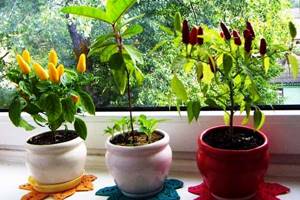
Any hot pepper . And “Peter Pepper” will surprise you not only with its excellent medium-spicy taste, but also with its very original appearance.
Not demanding in care. But it is very exotic on the windowsill, thanks to the unusual shape of its fruits.
It comes in both red and yellow. It blooms and bears fruit, with timely feeding, 3-4 times a year, starting from three months. The fruits ripen within 60 days.
Any selected exotic plants will decorate the room, become a source of pride and delight you with their aroma, flowering and fruits.
How to grow pineapple
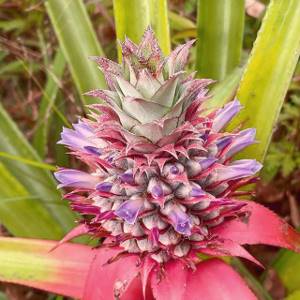
Meanwhile, growing such an exotic fruit as pineapple is even easier than citrus fruits. Pineapple is unpretentious, does not experience discomfort due to the dry air of apartments and does not require spraying. The fruit does not get sick and is not affected by pests. And if you forget to water the plant, it will tolerate it without any problems.
You can start growing pineapple at home by cutting off the green top with a small part of the fruit from the purchased fruit. Choose an unlit place and dry the future seedling there. The most convenient way to dry is to hang it on a rope with the leaves down and the cut side up. After a week, the cut of the shoot will dry out and you will need to sprinkle it with charcoal. Having chosen a small pot, prepare a mixture of soil there: birch sawdust and dust - 20%, peat - 20%, leaf soil - 20%, turf soil - 30% and coarse sand - 10%. Pre-heat this mixture in the oven. Broken brick or river sand will be excellent drainage.
Plant the prepared top to a depth of 3 cm, compact the soil and water with potassium permanganate. Covering with a glass jar or bag will help maintain regular humidity. Pineapple loves high temperatures (more than +25 degrees) and does not tolerate direct sunlight. But at the same time, shade is also contraindicated for him; in winter, use artificial lighting.
After six weeks, the cuttings will root. Young leaves on the shoot will be the first sign of root formation. Your next step should be to buy a large pot and replant the plant there. Do not forget about fertilizing with mineral fertilizers.
Pineapple roots are shallow, so you will need a bowl that is wide but not tall. You need to lay out a drainage layer on the bottom of the pot and make several holes. To make your pineapple grow faster, regularly remove the growing point at the apical rosette. Water moderately in summer and lightly in winter.
Several years will pass and you will see the result: a pineapple fruit grown with your own hands on the windowsill of your apartment, and you will not regret that you planted a shoot of this exotic plant at one time.
How to grow feijoa at home
This plant is quite unpretentious, so even an amateur can grow feijoa at home. You need to purchase plant seeds or prepare them yourself from fresh ripe fruits. The soil for feijoa should be a mixture of fertile soil, sand and peat. But you shouldn’t hope for quick fruits; experts say that the first flowers on the plant will appear after a few years. Feijoa is a light-loving plant that needs to be watered moderately throughout the year. It is imperative to monitor the quality of water; lime can destroy the plant. In summer, you can put the plant in the garden or on the veranda.
Growing lemon at home
Lemon can most often be found on the window sills of gardeners, but growing it is not so easy. The conditions for growing lemons at home are similar to those in which tangerines are grown, since both plants belong to the citrus family. The fruits of home-grown lemons have a special aroma and a bitter, tart taste. Homemade lemons are much smaller than those sold in stores, but this does not at all spoil the good mood of the successful gardener.
Source: https://mirsovet.ru
Series of messages “House Plants”:
Part 1 - Adenium obesum Part 2 - Alocasia sanderiana ... Part 13 - Gesneriaceae family. Care is simple, but the joy is endless. Part 14 - How to properly care for violets: watering, soil, fertilizing, diseases Part 15 - What exotic fruits can be grown at home Part 16 - Prickly aristocrats Part 17 - Prickly old man. Cephalocereus senile ... Part 38 - Plant damage, pests and diseases.2 Part 39 - Plant damage, pests and diseases.3 Part 40 - Methods and means of controlling pests and diseases of indoor plants.
Vegetables
Let's start with what can serve as an excellent addition to ready-made dishes in the form of a salad or snack. We deliberately did not include the most common vegetables in this selection, since you won’t surprise anyone with homemade cucumbers and tomatoes. When you reveal the secret that the vegetables on this list were grown at home, you will create a real sensation among your guests and the entire dinner party will be spent asking how you did it.
Pepper
With the right choice of pepper variety, its stay on your windowsill will be as fruitful as possible. Pepper does not require special care, however, its unpretentiousness is followed by a long wait for the first results, which will appear only after six months. Care tips can be summarized in one sentence: peppers should be grown on the sunny side, try to protect them from drafts, protect them from pests by feeding them with vitamins and loosening the soil.
For general care you will need tools, and in order not to look separately for one tool for weeding and another for cleaning, just pay attention to the special “Home Gardening Set” from the German brand GARDENA. The set contains everything you need to care for house plants, such as a scoop for planting and replanting plants, a hoe for weeding the soil, and pruning shears. The set also includes a scoop lid and a brush that will help in cleaning the workplace, and a plastic container is perfect for storing all the tools.
In addition, do not forget to tie up the peppers during fruiting. Then dishes made from tasty and crispy peppers will always be on your menu.
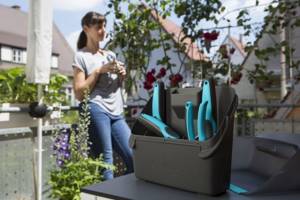
Carrot
Thanks to its undeniable benefits for human health and unpretentious care, carrots have become a regular guest on the balcony. After just three months of being indoors, she will be comfortable enough to thank you for your hospitality. To care for it, you will need to provide it with draining soil, since the root crop needs access to oxygen. You should also avoid exposure to direct sunlight and focus on temperatures between 15 and 25 °C. Carrots are a very gluttonous vegetable, so they will need additional moisture and regular watering. The last thing to pay attention to is the growing container. Carrots feel great in a plastic bottle, so you don’t have to worry about its safety.
Beans
In many countries, beans are an integral part of breakfast due to their nutritional value. To include homemade beans in your diet, just plant them in a small two-liter container (bush variety), and within two months they will have their first pods ready for cooking. Bean bushes should be placed in a bright room, as this species loves warmth. To grow climbing varieties, you will need larger containers of up to 35 liters, as well as additional accessories for garter. For climbing beans, the presence of sun or its absence does not matter; it will grow obediently in any conditions.

